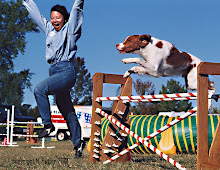Dogs are very social creatures, and they often crave attention from their humans. Cats can also be very attached to their people. Attention seeking behaviors can range from sitting next to, and staring at the human of interest, to touching, licking, jumping, vocalizing, scratching, biting, humping and stealing to demand attention.
This is a mild behavior problem that can be extremely annoying for owners and their friends. Often the barrier to fixing this problem is not the pet, but the owners who inadvertantly reward the attention-seeking behavior. It is important to realize that attention comes in multiple forms, including touching, speaking to, or even looking at the pet. Some pets also do not recognize the difference between positive attention (petting, cooing) and negative attention (punishment); attention is attention!
The obvious solution to the problem of attention-seeking behavior is to (1) teach the pet when and how it is appropriate to solicit attention, and (2) remove all attention from the pet when he actively solicits it otherwise.
It may help to have scheduled interactions with the pet. Keeping activities such as playing, brushing, and teaching tricks on a regular, predictable schedule can help the pet, particularly if he is anxious. I recommend 15 minutes in the morning and 15 minutes in the evening for the quality interaction.
Also employing the "Nothing in Life is Free" philosophy (see post on this blog from June 2009) can help to set up a way for the dog to ask for attention in a manner that is not obnoxious, or that feeds into his anxiety.
What should be done if the pet acts in an unacceptable manner to solicit attention? Below is a list of common behaviors and solutions:
1. Touching, head on lap or foot, leaning against the leg; also licking - Remove your body part from the pet. If the pet persists, get up and leave the room.
2. Jumping, jumping onto your lap - Silently turn away from the dog and allow the dog's paws to slough off your body. If you are seated, slowly rise without touching the dog and allow the dog to slide off your lap. If the dog persists and tries to jump on your back, walk away, and put a door between you and the dog. Do not push the dog off you or knee the dog, for that provides negative attention (and remember, negative attention is still attention!).
3. Vocalizing (this can run the gamut from whining to vociferous barking and screaming) - Ignore the dog. Put in ear plugs, listen to an MP3 player through ear phones. If not ignored, this particular behavior has great potential to escalate.
4. Humping (owner, other pets, or inanimate objects) - Ignore the dog unless the victim is in danger. If the pet is humping your leg, remove your body part and walk away without saying a word.
5. Stealing (shoes, remote controls, children's toys, etc.) - Ignore the dog unless he is in danger. When the dog seems to lose interest, call the dog to you, make him sit (Nothing in life is free!), then reward him for the sit. Then, isolate the dog and retrieve the stolen item.
6. Scratching, biting - When the pet does bodily harm in the attempt to demand attention, try to keep any limbs in close to the body so there is as little as possible to "grab". You may need to use an aversive to prevent the harmful behavior. The aversive would in response to behavior that precedes the bodily contact, including stalking, eye contact, and sometimes even approach. Aversives include sounding an air horn, using a battery-powered water gun, using a citronella-scented compressed air canister (
Spray Shield). If the people in the household need to be reminded to be vigilant about the pet's behavior, consider having the pet wear a bell attached to the collar.
It is easier to list what one should NOT do, it is harder for most owners to remember what they SHOULD do. If your pet approaches you and sits, pay attention to your pet, for he has just exhibited polite behavior and should be accordingly rewarded.







